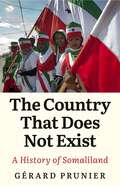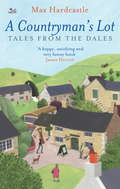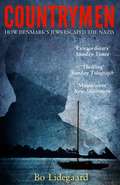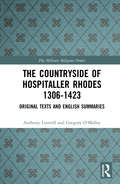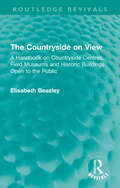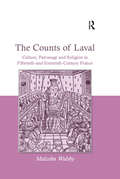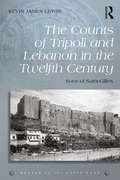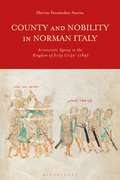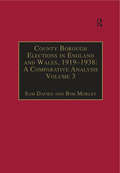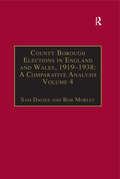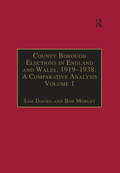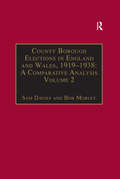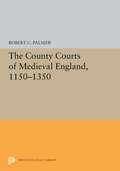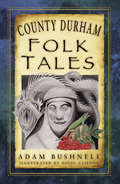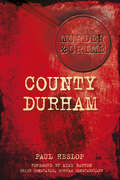- Table View
- List View
The Country That Does Not Exist: A History of Somaliland
by Gérard PrunierThe Somali people are fiercely nationalistic. Colonialism split them into five segments divided between four different powers. Thus decolonization and pan-Somalism became synonymous. In 1960 a partial reunification took place between British Somaliland and Somalia Italiana. Africa Confidential wrote at the time that the new Somali state would never be beset by tribal division but this discounted the existence of powerful clans within Somali society and the persistence of colonial administrative cultures. The collapse of parliamentary democracy in 1969 and the resulting army--and clanic--dictatorship that followed led to a civil war in the 'perfect' national state. It lasted fourteen years in the "British" North and is still raging today in the 'Italian' South. Somaliland "re-birthed" itself through an enormous solo effort but the viable nation so recreated within its former colonial borders was never internationally recognized and still struggles to exist economically and diplomatically. This book recounts an African success story where the peace so widely acclaimed by the international community has had no reward but its own lonely achievement.
The Country That Does Not Exist: A History of Somaliland
by Gérard PrunierThe Somali people are fiercely nationalistic. Colonialism split them into five segments divided between four different powers. Thus decolonization and pan-Somalism became synonymous. In 1960 a partial reunification took place between British Somaliland and Somalia Italiana. Africa Confidential wrote at the time that the new Somali state would never be beset by tribal division but this discounted the existence of powerful clans within Somali society and the persistence of colonial administrative cultures. The collapse of parliamentary democracy in 1969 and the resulting army--and clanic--dictatorship that followed led to a civil war in the 'perfect' national state. It lasted fourteen years in the "British" North and is still raging today in the 'Italian' South. Somaliland "re-birthed" itself through an enormous solo effort but the viable nation so recreated within its former colonial borders was never internationally recognized and still struggles to exist economically and diplomatically. This book recounts an African success story where the peace so widely acclaimed by the international community has had no reward but its own lonely achievement.
A Countryman's Lot: Tales From The Dales
by Max HardcastleMax and Vicky Hardcastle have a daydream . . .One day, they'll sell their cramped city-centre antiques shop and the overflowing upstairs flat and relocate to the beautiful Yorkshire Dales. If they could only find the perfect place to house both family and business, then that fantasy might become a reality. . . When a smallholding in a remote Dales village comes on the market, it seems like the answer to their prayers. Bullpen Farm might need 'some renovation', but it has an orchard, outbuildings and all the charm they've dreamt of. Before long, the Hardcastles find themselves the proud owners of a collection of ramshackle buildings and the newest members of a close-knit community which seems to have more than its fair share of eccentrics.From the antics of the antiques trade to the uproarious incidents of village life, it turns out that rural living isn't quite as tranquil as they'd imagined!'A happy, satisfying and very funny book' James Herriot
Countrymen: The Untold Story of How Denmark's Jews Escaped the Nazis
by Bo LidegaardThe rescue of the Danish Jews from Nazi persecution in October 1943 is a unique exception to the tragic history of the Holocaust. Over fourteen harrowing days, as they were helped, hidden and protected by ordinary people who spontaneously rushed to save their fellow citizens, an incredible 7,742 out of 8,200 Jewish refugees were smuggled out all along the coast - on ships, schooners, fishing boats, anything that floated - to Sweden. Now, for the first time, Bo Lidegaard brings together decades of research and new evidence, including unpublished diaries and documents of families forced to run for safety and of those who courageously came to their aid, to tell this story of ordinary glory, of simple courage and moral fortitude that shines out in the midst of the terrible history of the twentieth century and demonstrates how it was possible for a small and fragile democracy to stand against the Third Reich.
The Countryside Of Hospitaller Rhodes 1306-1423: Original Texts And English Summaries
by Anthony Luttrell Greg O'MalleyThe Countryside of Hospitaller Rhodes 1306–1423 explores the main themes of settlement, population and defence of the countryside of Rhodes from 1306 to 1423, approximately halfway through the period of Hospitaller rule. Based largely on the Hospital’s Rhodian archive, this book is the scientific presentation of 208 documents brought together with detailed English summaries to help readers understand the documents and their technical features. While the majority of research into this subject has previously been focused on the town of Rhodes, this book concentrates instead on the late-medieval countryside, providing a new angle from which to view this complex period. Through a corpus of Hospitaller texts, it presents many aspects of the Hospitaller Order’s history as well as exploring other crucial developments in the period, including both a discussion of Cristoforo Buondelmonti’s description of Rhodes, and a section dedicated to the sources used within this work. The Countryside of Hospitaller Rhodes provides an ideal for academics and postgraduates of the crusades.
The Countryside Of Hospitaller Rhodes 1306-1423: Original Texts And English Summaries
by Anthony Luttrell Greg O'MalleyThe Countryside of Hospitaller Rhodes 1306–1423 explores the main themes of settlement, population and defence of the countryside of Rhodes from 1306 to 1423, approximately halfway through the period of Hospitaller rule. Based largely on the Hospital’s Rhodian archive, this book is the scientific presentation of 208 documents brought together with detailed English summaries to help readers understand the documents and their technical features. While the majority of research into this subject has previously been focused on the town of Rhodes, this book concentrates instead on the late-medieval countryside, providing a new angle from which to view this complex period. Through a corpus of Hospitaller texts, it presents many aspects of the Hospitaller Order’s history as well as exploring other crucial developments in the period, including both a discussion of Cristoforo Buondelmonti’s description of Rhodes, and a section dedicated to the sources used within this work. The Countryside of Hospitaller Rhodes provides an ideal for academics and postgraduates of the crusades.
The Countryside on View: A Handbook on Countryside Centres, Field Museums and Historic Buildings Open to the Public (Routledge Revivals)
by Elisabeth BeazleyOriginally published in 1971 The Countryside on View is a handbook which provides extensive information about the many ways in which visitors to rural areas may find out about what they have come to enjoy. A major part of it concerns small countryside centres which house information services and which are designed to give both the casual visitor and organised educational parties a deeper understanding of the place they have come to see. The book also has chapters on the techniques involved in the showing of historic monuments and buildings, from lonely cromlechs and romantic ruins to churches, house, bridges and other structures which are still in use. A pioneering work in the field of Museum Studies.
The Countryside on View: A Handbook on Countryside Centres, Field Museums and Historic Buildings Open to the Public (Routledge Revivals)
by Elisabeth BeazleyOriginally published in 1971 The Countryside on View is a handbook which provides extensive information about the many ways in which visitors to rural areas may find out about what they have come to enjoy. A major part of it concerns small countryside centres which house information services and which are designed to give both the casual visitor and organised educational parties a deeper understanding of the place they have come to see. The book also has chapters on the techniques involved in the showing of historic monuments and buildings, from lonely cromlechs and romantic ruins to churches, house, bridges and other structures which are still in use. A pioneering work in the field of Museum Studies.
The Counts of Laval: Culture, Patronage and Religion in Fifteenth- and Sixteenth-Century France
by Malcolm WalsbyThe Lavals were one of the most important families in late medieval France, rising to a position of unsurpassed eminence by the mid sixteenth century. Yet, at the very point where they reached this position of unrivalled importance, all was put at risk by the dual challenges of dynastic failure and the Reformation. The vagaries of dynastic failure threatened their hard won success and these problems were compounded by the decision of crucial members of the family to support Protestantism in the middle of the century. By the end of the sixteenth century the fortunes of the family were in ruins and the brief eminence of Lavals in western France was over. This monograph offers a fresh look at several of the critical questions facing historians of late medieval and early modern France. It re-examines the clientage of a rising and enterprising family and explores the cultural patronage of a noble court. The book also provides a new insight into the nature of noble Protestantism, notably analysing the connections between nobles, patterns of family loyalty and religious conviction. Finally, it considers the events of wars of religion in western France from the perspective of a noble leadership that simultaneously played a vital role in sustaining the cause and did much to undermine it. This latter issue is examined in particular through the analysis of the relationship between the houses of Laval and Rohan, two Protestant families with shared loyalties but with rival dynastic ambitions. This study is based on a complete re-examination of the archive base in both Paris and the west of France and in English archives. For many centuries the destruction of the archives of the family of Laval during the French Revolution has prevented historians from undertaking a serious study of the family. Indeed, this book is the first monograph to be published on the Comtes de Laval since the manuscript volume written by Le Blanc de La Vignole in the seventeenth century. At the same time it engages with the historiography of both French and Anglo-Saxon historiographical traditions.
The Counts of Laval: Culture, Patronage and Religion in Fifteenth- and Sixteenth-Century France
by Malcolm WalsbyThe Lavals were one of the most important families in late medieval France, rising to a position of unsurpassed eminence by the mid sixteenth century. Yet, at the very point where they reached this position of unrivalled importance, all was put at risk by the dual challenges of dynastic failure and the Reformation. The vagaries of dynastic failure threatened their hard won success and these problems were compounded by the decision of crucial members of the family to support Protestantism in the middle of the century. By the end of the sixteenth century the fortunes of the family were in ruins and the brief eminence of Lavals in western France was over. This monograph offers a fresh look at several of the critical questions facing historians of late medieval and early modern France. It re-examines the clientage of a rising and enterprising family and explores the cultural patronage of a noble court. The book also provides a new insight into the nature of noble Protestantism, notably analysing the connections between nobles, patterns of family loyalty and religious conviction. Finally, it considers the events of wars of religion in western France from the perspective of a noble leadership that simultaneously played a vital role in sustaining the cause and did much to undermine it. This latter issue is examined in particular through the analysis of the relationship between the houses of Laval and Rohan, two Protestant families with shared loyalties but with rival dynastic ambitions. This study is based on a complete re-examination of the archive base in both Paris and the west of France and in English archives. For many centuries the destruction of the archives of the family of Laval during the French Revolution has prevented historians from undertaking a serious study of the family. Indeed, this book is the first monograph to be published on the Comtes de Laval since the manuscript volume written by Le Blanc de La Vignole in the seventeenth century. At the same time it engages with the historiography of both French and Anglo-Saxon historiographical traditions.
The Counts of Tripoli and Lebanon in the Twelfth Century: Sons of Saint-Gilles (Rulers of the Latin East)
by Kevin James LewisThe county of Tripoli in what is now North Lebanon is arguably the most neglected of the so-called ‘crusader states’ established in the Middle East at the beginning of the twelfth century. The present work is the first monograph on the county to be published in English, and the first in any western language since 1945. What little has been written on the subject previously has focused upon the European ancestry of the counts of Tripoli: a specifically Southern French heritage inherited from the famous crusader Raymond IV of Saint-Gilles. Kevin Lewis argues that past historians have at once exaggerated the political importance of the counts’ French descent and ignored the more compelling signs of its cultural impact, highlighting poetry composed by troubadours in Occitan at Tripoli’s court. For Lewis, however, even this belies a deeper understanding of the processes that shaped the county. What emerges is an intriguing portrait of the county in which its rulers struggled to exert their power over Lebanon in the face of this region’s insurmountable geographical forces and its sometimes bewildering, always beguiling diversity of religions, languages and cultures. The counts of Tripoli and contemporary Muslim onlookers certainly viewed the dynasty as sons of Saint-Gilles, but the county’s administration relied upon Arabic, its stability upon the mixed loyalties of its local inhabitants, and its very existence upon the rugged mountains that cradled it. This book challenges prevailing knowledge of this little-known crusader state and by extension the medieval Middle East as a whole. .
The Counts of Tripoli and Lebanon in the Twelfth Century: Sons of Saint-Gilles (Rulers of the Latin East)
by Kevin James LewisThe county of Tripoli in what is now North Lebanon is arguably the most neglected of the so-called ‘crusader states’ established in the Middle East at the beginning of the twelfth century. The present work is the first monograph on the county to be published in English, and the first in any western language since 1945. What little has been written on the subject previously has focused upon the European ancestry of the counts of Tripoli: a specifically Southern French heritage inherited from the famous crusader Raymond IV of Saint-Gilles. Kevin Lewis argues that past historians have at once exaggerated the political importance of the counts’ French descent and ignored the more compelling signs of its cultural impact, highlighting poetry composed by troubadours in Occitan at Tripoli’s court. For Lewis, however, even this belies a deeper understanding of the processes that shaped the county. What emerges is an intriguing portrait of the county in which its rulers struggled to exert their power over Lebanon in the face of this region’s insurmountable geographical forces and its sometimes bewildering, always beguiling diversity of religions, languages and cultures. The counts of Tripoli and contemporary Muslim onlookers certainly viewed the dynasty as sons of Saint-Gilles, but the county’s administration relied upon Arabic, its stability upon the mixed loyalties of its local inhabitants, and its very existence upon the rugged mountains that cradled it. This book challenges prevailing knowledge of this little-known crusader state and by extension the medieval Middle East as a whole. .
County and Nobility in Norman Italy: Aristocratic Agency in the Kingdom of Sicily, 1130-1189
by Hervin Fernández-AcevesWhilst historians often regard the Norman Kingdom of Sicily as centralised and administratively advanced, County and Nobility in Norman Italy counters this traditional interpretation; far from centralised and streamlined, this book reveals how the genesis and social structures of the kingdom were constantly fraught between the forces of royal power and local aristocracy authority. In doing so, Hervin Fernandez-Aceves sheds important new light on medieval Italy. This book is the result of thorough research conducted on the vast source material for the history of this fascinating 12th-century world. Starting with the activities of Norman counts and the configuration of the counties, it explores how social control operated in these nodes of regional authority, and argues that the Sicilian monarchy relied on the counties (and the counts' authority) to keep the realm united and exercise control.
County and Nobility in Norman Italy: Aristocratic Agency in the Kingdom of Sicily, 1130-1189
by Hervin Fernández-AcevesWhilst historians often regard the Norman Kingdom of Sicily as centralised and administratively advanced, County and Nobility in Norman Italy counters this traditional interpretation; far from centralised and streamlined, this book reveals how the genesis and social structures of the kingdom were constantly fraught between the forces of royal power and local aristocracy authority. In doing so, Hervin Fernandez-Aceves sheds important new light on medieval Italy. This book is the result of thorough research conducted on the vast source material for the history of this fascinating 12th-century world. Starting with the activities of Norman counts and the configuration of the counties, it explores how social control operated in these nodes of regional authority, and argues that the Sicilian monarchy relied on the counties (and the counts' authority) to keep the realm united and exercise control.
County Borough Elections in England and Wales, 1919–1938: Volume 3: Chester to East Ham (County Borough Elections in England and Wales, 1919-1938)
by Sam Davies Bob MorleyThese volumes provide an essential comprehensive work of reference for the annual municipal elections that took place each November in the 83 County Boroughs of England and Wales between 1919 and 1938. They also provide an extensive and detailed analysis of municipal politics in the same period, both in terms of the individual boroughs and of aggregate patterns of political behaviour. Being annual, these local election results give the clearest and most authoritative record of how political opinion changed between general elections, especially useful for research into the longer gaps such as 1924-29 and 1935-45, or crisis periods such as 1929-31. They also illuminate the impact of fringe parties such as the Communist Party and the British Union of Fascists, and also such questions as the role of women in politics, the significance of religious and ethnic differentiation and the connection between occupational and class divisions and party allegiance. Analysis at the ward level is particularly useful for socio-spatial studies. A major work of reference, County Borough Elections in England and Wales, 1919-1938 is indispensable for university libraries and local and national record offices. Each volume has approximately 700 pages.
County Borough Elections in England and Wales, 1919–1938: Volume 4: Exeter - Hull (County Borough Elections in England and Wales, 1919-1938)
by Sam Davies Bob MorleyThese volumes provide an essential comprehensive work of reference for the annual municipal elections that took place each November in the 83 County Boroughs of England and Wales between 1919 and 1938. They also provide an extensive and detailed analysis of municipal politics in the same period, both in terms of the individual boroughs and of aggregate patterns of political behaviour. Being annual, these local election results give the clearest and most authoritative record of how political opinion changed between general elections, especially useful for research into the longer gaps such as 1924-29 and 1935-45, or crisis periods such as 1929-31. They also illuminate the impact of fringe parties such as the Communist Party and the British Union of Fascists, and also such questions as the role of women in politics, the significance of religious and ethnic differentiation and the connection between occupational and class divisions and party allegiance. Analysis at the ward level is particularly useful for socio-spatial studies. A major work of reference, County Borough Elections in England and Wales, 1919-1938 is indispensable for university libraries and local and national record offices. Each volume has approximately 700 pages.
County Borough Elections in England and Wales, 1919–1938: Volume 1: Barnsley - Bournemouth (County Borough Elections in England and Wales, 1919-1938)
by Sam Davies Bob MorleyThese volumes provide an essential comprehensive work of reference for the annual municipal elections that took place each November in the 83 County Boroughs of England and Wales between 1919 and 1938. They also provide an extensive and detailed analysis of municipal politics in the same period, both in terms of the individual boroughs and of aggregate patterns of political behaviour. Being annual, these local election results give the clearest and most authoritative record of how political opinion changed between general elections, especially useful for research into the longer gaps such as 1924-29 and 1935-45, or crisis periods such as 1929-31. They also illuminate the impact of fringe parties such as the Communist Party and the British Union of Fascists, and also such questions as the role of women in politics, the significance of religious and ethnic differentiation and the connection between occupational and class divisions and party allegiance. Analysis at the ward level is particularly useful for socio-spatial studies. A major work of reference, County Borough Elections in England and Wales, 1919-1938 is indispensable for university libraries and local and national record offices. Each volume has approximately 700 pages.
County Borough Elections in England and Wales, 1919–1938: Volume 2: Bradford - Carlisle (County Borough Elections in England and Wales, 1919-1938)
by Sam Davies Bob MorleyThese volumes provide an essential comprehensive work of reference for the annual municipal elections that took place each November in the 83 County Boroughs of England and Wales between 1919 and 1938. They also provide an extensive and detailed analysis of municipal politics in the same period, both in terms of the individual boroughs and of aggregate patterns of political behaviour. Being annual, these local election results give the clearest and most authoritative record of how political opinion changed between general elections, especially useful for research into the longer gaps such as 1924-29 and 1935-45, or crisis periods such as 1929-31. They also illuminate the impact of fringe parties such as the Communist Party and the British Union of Fascists, and also such questions as the role of women in politics, the significance of religious and ethnic differentiation and the connection between occupational and class divisions and party allegiance. Analysis at the ward level is particularly useful for socio-spatial studies. A major work of reference, County Borough Elections in England and Wales, 1919-1938 is indispensable for university libraries and local and national record offices. Each volume has approximately 700 pages.
County Borough Elections in England and Wales, 1919–1938: Volume 2: Bradford - Carlisle (County Borough Elections in England and Wales, 1919-1938)
by Sam Davies Bob MorleyThese volumes provide an essential comprehensive work of reference for the annual municipal elections that took place each November in the 83 County Boroughs of England and Wales between 1919 and 1938. They also provide an extensive and detailed analysis of municipal politics in the same period, both in terms of the individual boroughs and of aggregate patterns of political behaviour. Being annual, these local election results give the clearest and most authoritative record of how political opinion changed between general elections, especially useful for research into the longer gaps such as 1924-29 and 1935-45, or crisis periods such as 1929-31. They also illuminate the impact of fringe parties such as the Communist Party and the British Union of Fascists, and also such questions as the role of women in politics, the significance of religious and ethnic differentiation and the connection between occupational and class divisions and party allegiance. Analysis at the ward level is particularly useful for socio-spatial studies. A major work of reference, County Borough Elections in England and Wales, 1919-1938 is indispensable for university libraries and local and national record offices. Each volume has approximately 700 pages.
County Borough Elections in England and Wales, 1919–1938: Volume 3: Chester to East Ham (County Borough Elections in England and Wales, 1919-1938)
by Sam Davies Bob MorleyThese volumes provide an essential comprehensive work of reference for the annual municipal elections that took place each November in the 83 County Boroughs of England and Wales between 1919 and 1938. They also provide an extensive and detailed analysis of municipal politics in the same period, both in terms of the individual boroughs and of aggregate patterns of political behaviour. Being annual, these local election results give the clearest and most authoritative record of how political opinion changed between general elections, especially useful for research into the longer gaps such as 1924-29 and 1935-45, or crisis periods such as 1929-31. They also illuminate the impact of fringe parties such as the Communist Party and the British Union of Fascists, and also such questions as the role of women in politics, the significance of religious and ethnic differentiation and the connection between occupational and class divisions and party allegiance. Analysis at the ward level is particularly useful for socio-spatial studies. A major work of reference, County Borough Elections in England and Wales, 1919-1938 is indispensable for university libraries and local and national record offices. Each volume has approximately 700 pages.
County Borough Elections in England and Wales, 1919–1938: Volume 4: Exeter - Hull (County Borough Elections in England and Wales, 1919-1938)
by Sam Davies Bob MorleyThese volumes provide an essential comprehensive work of reference for the annual municipal elections that took place each November in the 83 County Boroughs of England and Wales between 1919 and 1938. They also provide an extensive and detailed analysis of municipal politics in the same period, both in terms of the individual boroughs and of aggregate patterns of political behaviour. Being annual, these local election results give the clearest and most authoritative record of how political opinion changed between general elections, especially useful for research into the longer gaps such as 1924-29 and 1935-45, or crisis periods such as 1929-31. They also illuminate the impact of fringe parties such as the Communist Party and the British Union of Fascists, and also such questions as the role of women in politics, the significance of religious and ethnic differentiation and the connection between occupational and class divisions and party allegiance. Analysis at the ward level is particularly useful for socio-spatial studies. A major work of reference, County Borough Elections in England and Wales, 1919-1938 is indispensable for university libraries and local and national record offices. Each volume has approximately 700 pages.
County Borough Elections in England and Wales, 1919–1938: Volume 1: Barnsley - Bournemouth (County Borough Elections in England and Wales, 1919-1938)
by Sam Davies Bob MorleyThese volumes provide an essential comprehensive work of reference for the annual municipal elections that took place each November in the 83 County Boroughs of England and Wales between 1919 and 1938. They also provide an extensive and detailed analysis of municipal politics in the same period, both in terms of the individual boroughs and of aggregate patterns of political behaviour. Being annual, these local election results give the clearest and most authoritative record of how political opinion changed between general elections, especially useful for research into the longer gaps such as 1924-29 and 1935-45, or crisis periods such as 1929-31. They also illuminate the impact of fringe parties such as the Communist Party and the British Union of Fascists, and also such questions as the role of women in politics, the significance of religious and ethnic differentiation and the connection between occupational and class divisions and party allegiance. Analysis at the ward level is particularly useful for socio-spatial studies. A major work of reference, County Borough Elections in England and Wales, 1919-1938 is indispensable for university libraries and local and national record offices. Each volume has approximately 700 pages.
The County Courts of Medieval England, 1150-1350 (Princeton Legacy Library #5461)
by Robert C. PalmerThe first monograph on English medieval county courts, this book provides a major revision of traditional conceptions of the character of these courts and the organization of English society from the twelfth to the fourteenth century. THe county courts have been considered courts of custom dominated by local knights unskilled in the law. By analyzing county peronnel and their role of the courts, Robert C. Palmer shows that these courts were, on the contrary, clearly professional and controlled by the magnates through their lawyers. Nevertheless, as the author demonstrates by his study of the process of jurisdictional change, the county courts were increasingly relegated to lesser roles by changes meant to assure justice to county litigants, while the king's court became the normal court of original jurisdiction for most important cases.Professor Palmer appraoches his subject through the study of original records of litigation. Some of his primary sources were unkown until now (the county court year book reports and the writ file records) and some (the king's court plea rolls of Edward I, the unedited Cheshire plea rolls, and the early close rolls) had not previously been so closely examined for evidence on the county courts.In this ambitious work the author has shown how the king's courts and the county and local courts were linekd by personnel and procedure and how legal innovations and other circumstances broke down these links. What emerges is an enlightening study of legal and constitutional change.Robert C. Palmer is a Junior Fellow of the Michigan Society of Fellows at the University of Michigan Law School.Originally published in 1982.The Princeton Legacy Library uses the latest print-on-demand technology to again make available previously out-of-print books from the distinguished backlist of Princeton University Press. These editions preserve the original texts of these important books while presenting them in durable paperback and hardcover editions. The goal of the Princeton Legacy Library is to vastly increase access to the rich scholarly heritage found in the thousands of books published by Princeton University Press since its founding in 1905.
County Durham Folk Tales
by Adam BushnellSTORYTELLER and author Adam Bushnell brings together stories from the rugged coastlines, limestone cliffs, remote moorland, pastoral dales and settled coalfields of County Durham. In this treasure trove of tales you will meet the evil fairies of Weardale, the shape-changing witch from Easington, the Bishop Auckland boar, the Dun Cow from Durham City and many other characters – all as fantastical and powerful as the landscape they inhabit. Retold in an engaging style, and richly illustrated with unique line drawings, these humorous, clever and enchanting folk tales are sure to be enjoyed and shared time and again.
County Durham Murder & Crime (Murders Ser.)
by Paul HeslopThis collection brings together thirteen criminal cases from County Durham’s past that shocked not only the county but also made headline news across the country. Cases featured here include the murder of PC William Smith, who was stoned to death at Butterknowle; the shooting of Superintendent Joseph Scott at Durham by a former colleague; a robbery and murder at Ferryhill, when bank clerk William Byland Abbey was stabbed to death; and the case of Charles Conlin, who killed his grandparents and buried them in a shallow grave at Norton-on-Tees. Paul Heslop’s well-illustrated and enthralling text will appeal to everyone interested in true crime and the shadier side of County Durham’s past.
